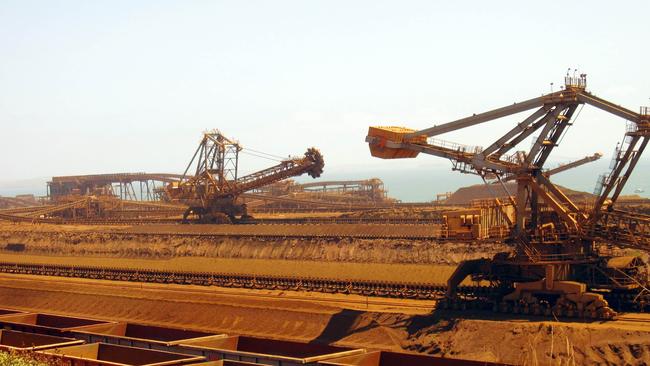Iron ore dive hits revenue expectations
The latest plunge in iron ore prices has prompted the nation’s forecaster to cut expectations for resources exports.

The latest sharp plunge in iron ore prices has prompted the nation’s official forecaster to cut its expectations for Australian resources exports, in a dent to government hopes for a mining-fuelled boost to coffers.
Figures from the Department of Industry, Innovation and Science — to be formally released today — will show that the nation’s resource and energy export earnings are now expected to reach $205 billion for 2016-17, some $9.9bn or 4.6 per cent lower than predicted by the department just three months ago.
The 2017 figures are expected to represent a high-water mark, with total exports from the sectors expected to fall in the next two years on the back of softer commodity prices and weaker demand out of China.
The department’s chief economist, Mark Cully, said the latest downgrade reflected the quicker-than-expected drop in iron ore prices since the previous forecast.
Since peaking at $US94.86 a tonne in February, the benchmark iron ore price slumped to a low of just $US53.36 last month. The steelmaking ingredient is now trading at around $US63.28 a tonne.
The department’s latest Resources and Energy Quarterly points to a fall in steel production in the coming years from China, which consumes about 82 per cent of Australia’s iron ore exports.
“(Chinese) government spending is expected to ease, and a renewed focus on financial stability and reining in debt is expected to dampen private investment and, as a result, steel consumption,” the report says.
The department also said it was too early to tell what sort of impact China’s latest infrastructure development initiative could have on resources demand.
“China’s recently announced ‘One Belt One Road’ plan has the potential to increase China’s steel needs beyond what has been forecast. However, there is insufficient clarity at this time regarding how the initiative will be implemented and, in turn, how it will affect steel demand,” the report says.
The soft demand outlook, coupled with expectations of more growth in low-cost supply, means the department is expecting the benchmark iron ore price to fall to $US48 a tonne next year and $US47 a tonne in 2019.
Such a level would squeeze margins at Australia’s big three iron ore producers — Rio Tinto, BHP and Fortescue Metals Group — and would leave smaller producers battling to stay afloat.
The department also expects to see softer revenues in the coking coal sector, which benefited from surging prices in 2016-17 due to Chinese coalmining restrictions and supply disruptions.
The pullback in coking coal prices is expected to wipe $11bn off the value of Australia’s resources exports over the next two years.
The falling iron ore and coking coal exports, however, will be partially offset by a rise in LNG exports following the looming start-up of the $US34bn Wheatstone and $US37bn Ichthys LNG projects over the coming year.
The department is forecasting the world LNG trade to grow by 7.4 per cent a year over the coming years, driven by increased demand from China and Europe.
However, demand from the world’s biggest LNG importer, Japan, is expected to drop from 83 million tonnes a year to 78 million tonnes in 2019 as it continues to restart the nuclear power generation capacity it shut down following the 2011 Fukushima disaster.
Australia’s resource and energy export earnings are forecast to decline marginally in 2017-18 to $202bn, according to the report, and then fall again to $200bn in 2018-19.
Mr Cully said the iron ore and coking coal price gains that drove last year’s surge in export earnings were not expected to last over the next two years.
“Global resource and energy commodity demand growth — particularly for steelmaking commodities — is expected to slow in the next two years, driven largely by a slowdown in infrastructure spending and construction activity in China. Lower demand growth is expected to adversely affect iron ore and metallurgical coal prices”, Mr Cully said.
It comes as Australia yesterday posted a larger-than-expected trade surplus in May, as coal exports recovered from a major storm earlier in the year. The nation recorded a seasonally adjusted trade surplus of $2.47bn in May, up from a surplus of $90 million in April, the Australian Bureau of Statistics said.
The sometimes volatile figure was larger than analysts’ expectations of a surplus of $1bn.
Coal exports jumped 62 per cent over the month, rebounding from the impact of Cyclone Debbie.



To join the conversation, please log in. Don't have an account? Register
Join the conversation, you are commenting as Logout